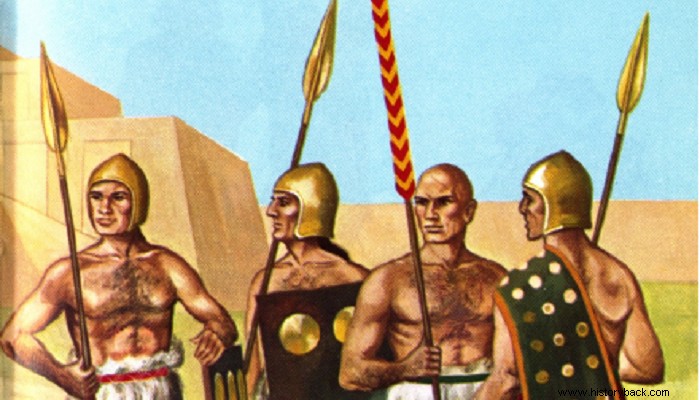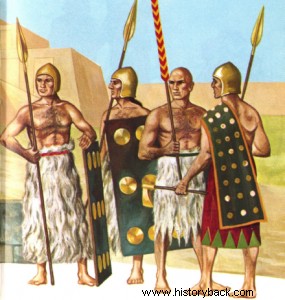
The Sumerians were an unknown people. Even the name by which they are known was given to them by archaeologists in the 19th century. Nevertheless, they left behind strong marks of their military art. From at least the 5th millennium, a great civilization flourished on the banks of the Tigris and Euphrates rivers, the Sumerian. The Sumerians lived in independent city-states, between which wars were an endemic phenomenon.
The armies of these states were small in size and had two main "components", tanks and infantry. Tanks were the maneuvering and striking element of the army, while the infantry was limited to a more passive role, having as its primary mission the interception of enemy tanks and as a secondary one the dominance of opposing infantry . Analogous to the mission was the armament carried by the footmen and consisted only of a long spear.
These satellites lined up in dense order in lines six fathoms deep, in phalanx formation, and as long as they kept their composure they were difficult to break by a frontal chariot advance. The flanks of the satellite formations were protected by divisions of skirmishers armed with bows, javelins and slings, Defensive armament of the satellites consisted only of a long leather cloak and a leather cap or (more rarely) helmet. It is easy to see that the defensive armor of the Sumerian infantry provided only rudimentary protection against enemy projectiles and spears.
A few centuries later, the shield was also introduced into the Sumerian arsenal, but this was not carried by the satellite himself, but by a second warrior. The shield bearers lined up in the first yoke of the formation of the satellites forming a continuous wall of shields. Behind this wall the satellites fought protected. It is not known whether there were shield-bearing soldiers in front of each pair of satellites.
It is most likely that there were shield bearers alone in front of the first yoke. The use of the shield allowed soldiers to be freed from the heavy and unwieldy leather cloak and dramatically increased their survivability. On the other hand, the heavy and large shield reduced the agility of the infantry.
It is not known whether there were Sumerian archer corps similar to the Egyptian ones, or whether Sumerian archers fought exclusively as acrobats. It is most likely that the two types coexisted, if not in the early, at least in the Akkadian period – 24th century BC. And during this period the armament of the infantry does not differ significantly, with the exception of the massive use of chisels, manuals and bayonets. The spear remains the main weapon of the infantry, but the heavy shield seems to be abandoned.
This fact mainly contributed to the nature of the operations that the infantry was called upon to carry out against the lightly armed and consequently agile mountain inhabitants of the area of Mount Zagros. In these businesses agility was a matter of prime importance. The shield reappeared at the end of the third millennium, This time its size was smaller and each satellite carried its own wooden and leather-covered shield, usually of Amorite origin.
Chariots entered the Sumerian arsenal around 2800 BC. These chariots were drawn by four usually unagagers and not by horses. Horses joined the Sumerian arsenal much later. Chariots were usually crewed by two men, a driver and a warrior, equipped with javelins. After the Akkadian conquest, the Sumerians recovered at the end of the 3rd millennium, with the 3rd Dynasty of Ur (2112-2004 BC).
During this period the army continued to equip and fight as before, with few exceptions. Among these exceptions we can include the replacement of part of the shock tanks with infantry transport vehicles , drawn by two horses, as well as the recruitment of a large number of mercenary light infantry, coming from the surrounding mountain tribes.
After the overthrow of the 3rd Dynasty of Ur, the Sumerians retreated to the marshy areas of the Tigris and Euphrates estuaries. There they resisted the Babylonians and the Assyrians until 1460 BC. In this last period, the shock tanks were permanently withdrawn due to a lack of horses. There were now only chariots for the transport of footmen, also drawn by onagarians. The infantry were more poorly armed and in most cases the infantry did not carry shields, but only long spears, or javelins.
There were also divisions of psilis, armed with bows and slings. From 1732 BC during the period of the so-called Dynasty of the Sea, a rudimentary navy also developed. With this navy, the last Sumerian kings managed to control the Persian Gulf, developing commercial contacts even with India.
It is worth noting that the Sumerians were the only people of the East whose infantry fought with long spears in deep phalanx formation. Of course the Sumerian phalanx had nothing to do with the corresponding phalanx. However, it did not differ much from the corresponding Minoan and early Mycenaean, a fact that still worries historians today.

